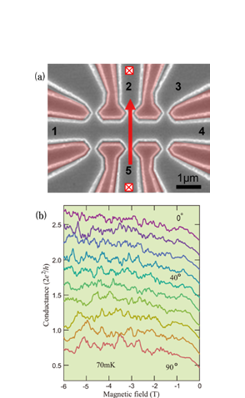“Zitterbewegung” Appeared as Conductance Fluctuation in Transport Between Quantum Point Contacts
Katsumoto Group
For a particle which obeys the Dirac equation, velocity is not a well-defined quantity in that the kinetic motion in real space is the mixed one of particle and anti-particle. Such a quantum mechanical state can be described as a superposition of states with velocities +c and –c. Hence in the space of velocity-base, such a particle is in a zigzag motion (trembling motion), which is called “Zitterbewegung” (ZB) in Germany[1]. A trivial analog in electrons in solids is oscillation in velocity of classical electrons due to periodic lattice potential. Even the experimental observation of such a trivial phenomenon is difficult at present. A bit non-trivial phenomenon closer to the ZB of electrons in vacuum is a zigzag motion of electrons due to the spin-orbit mixing of the two (spin and orbital) freedoms. This is also called ZB and expected to be observable in experiments though no clear observation has been reported yet.

Fig. 1. (a) QPC positioning in the sample. (b) Conductance fluctuation (through QPC 2 to 5) versus magnetic field. The field is rotated from 0º (parallel to the plane) to 90º (perpendicular).
For the observation of ZB in transport, we need to prepare spin-polarized electrons in a system with a simple-form spin-orbit interaction. We have experimentally confirmed that a quantum point contact (QPC) in a system with strong Rashba-type spin-orbit interaction (RSOI) can work as an efficient spin polarizer on plateaus of a half and of a one conductance quantum (2e2/h) [2]. Hence a system of QPCs with RSOI can provide an ideal test-bed of ZB in solids.
Figure 1(a) shows a schematic view of the present system with two sets of three parallel QPCs made from InAs 2DEG. The two are placed face-to-face. The two-terminal conductance through a confronting QPC pair (2-5) as a function of magnetic field for various field directions is shown in Fig.1 (b). Reproducible fluctuations reminiscent of universal conductance fluctuation (UCF) appear in the magneto-conductance. Surprisingly the amplitude nor the characteristic frequency does not change with the field angle. On the other hand in the transport not through QPC (terminal 1 to 4) no fluctuation appears and ordinal Shubnikov-de Haas oscillation appears for vertical magnetic field. In short the fluctuation appears only when the spins of conduction electrons are aligned.
The above results can be well explained within the ZB framework. The external magnetic field modifies the frequency of spin precession thus that of ZB, which results in large variation of scattering cross section. Superposition of various scattering paths leads to the observed conductance fluctuation.
References
- [1] W. Zawadzki and T. M. Rusin, J. Phys.: Condensed Matter 23, 143201 (2011).
- [2] M. Eto, T. Uehara, H. Taniguchi, K. Satoh, Y. Ishii, and I. Watanabe, J. Phys. Soc. Jpn. 84, 053703 (2015).
